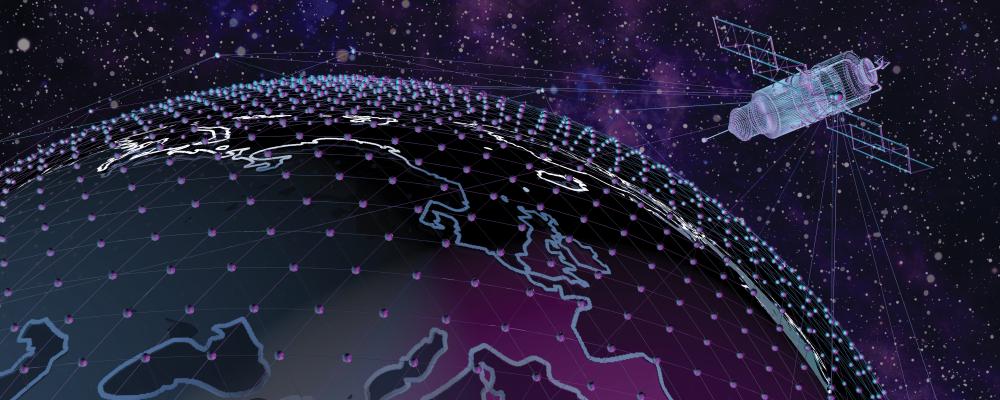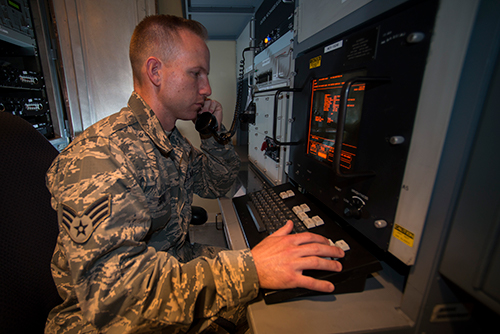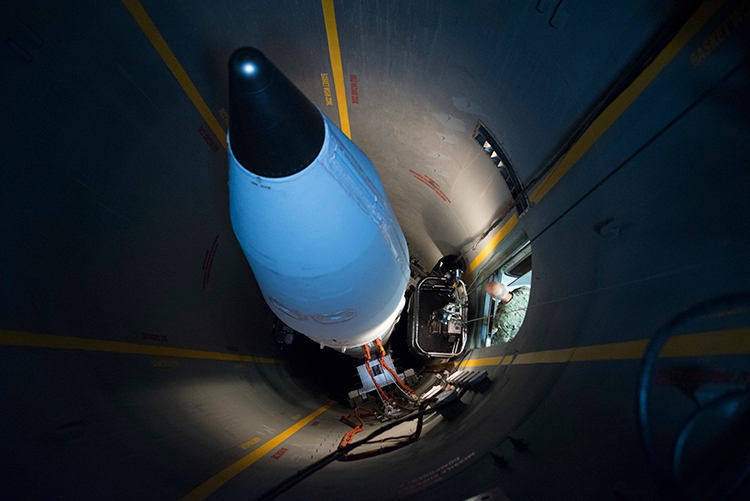
Guard contribution to the space mission is small in size,
yet unique in capability and significant in impact
Ancient militaries looked to the stars to navigate the globe. Modern forces continue looking skyward, but it’s manmade satellites, not celestial bodies, that are driving action on today’s battlefields.
Virtually every U.S. military operation in recent years relies on space capabilities. Communications, navigation and timing through global positioning, missile warning, signal and imagery intelligence, and weather and battlefield monitoring all rely on satellites.
National Guard space units — while a relatively small part of the overall force — make a big impact on behalf of the nation’s military operations, national defense and domestic operations.

Space Communications Group, monitors a computer in a mobile satellite trailer.
Specialized units in the Army and Air Guard are on standby 24/7 and some are among the most deployed forces in the military. They are standing watch in case of nuclear attack or missile launch, defending the nation’s satellites from attack and providing other types of support, including some classified operations, to assist troops around the globe.
With government leaders considering the creation of a separate Space Force — perhaps as the sixth branch of the U.S. armed forces — the Guard is ready to expand its role in this increasingly important and contested domain, officials say.
“The Guard has been in the space business for a very long time and we are an instrumental part of the current space enterprise,” says Air Force Col. Jason “3Dog” Knight, part of a planning team at the National Guard Bureau involved with looking at the future of the Guard in space.
Guardsmen provide both an enduring presence and a surge to war capability across a force that includes seven Air Guard space squadrons and an Army Guard space battalion.
Most of the units are clustered in Alaska, California, Colorado, Florida and New York. They include the 114th, 216th and 138th Space Control Squadrons, 137th and 213th Space Warning Squadrons, 148th Space Operations Squadron, 222nd Command and Control Squadron, and 117th Space Battalion.
Other units are the Air Guard’s 233rd Space Group and the Army Guard’s 100th Missile Defense Brigade. Both are based in Colorado, which has the largest concentration of Guard space units. That makes sense as the state is also home to Air Force Space Command, North American Aerospace Defense Command and a large portion of the U.S. space industry.
The Guard has been in the space business for a very long time and we are an instrumental part of the current space enterprise.
Col. Jason Knight, Space Planner, National Guard Bureau
The 100th has a subordinate unit in Alaska, the 49th Missile Defense Battalion, which provides launch crews for the interceptor missile system designed to defend the nation against a small-scale intercontinental ballistic missile (ICBM) attack.
But in all, the Guard space force amounts to just over 1,200 soldiers and airmen.
The first Guard space unit was established in 1995. Others were formed in the years following the Sept. 11, 2001, terrorist attacks.
Knight, who previously commanded the 137th Space Warning Squadron at Greeley Air National Guard Station, Colorado, says a fourth space control squadron is under consideration for somewhere in the western U.S./Pacific region. And the rest of the force is being postured for growth in the coming years.
That growth is meant in part to keep pace with operational demands as the Guard’s space force plays a key role in numerous training exercises and real-world missions, including domestic response.
The effort serves not only the U.S. military, but the intelligence community, the White House Situation Room and other national leaders. The work often goes unnoticed to the public with Guard space units playing a behind-the-scenes role in the initial volleys of the war against Iraq in 2003, the destruction of a failed U.S. satellite in 2008 and the interception and destruction of an ICBM during a training exercise last year.
Airmen provide early warning of missile launches, track potential enemy missiles in real time, have made more than 5.2 million observations of manmade objects in space and have spent tens of thousands of hours controlling important military satellite systems.
Others are on standby to respond to a ballistic missile or nuclear attack on the United States, prepared to deploy and operate in remote areas on short notice. Or maintain constant communications across the globe, linking Navy carrier groups, land forces and more into a global communications network.
And soldiers from the Colorado’s 117th Space Battalion — the only such unit in the Army Guard — are among the most deployed in the Guard. Two six-member space support teams from the unit, nicknamed Space Cowboys, are currently to the Middle East in support of warfighter intelligence and operational planning efforts. Of the Army’s 28 space support teams, a dozen belong to the 117th.
“They are in the fight right now,” Knight said. “They are fully involved.”
Space operations are both offensive and defensive. Guard soldiers and airmen are trained to prevent an adversary from negating U.S. space capabilities and can work against an enemy’s space capabilities through the “Five D’s” of deception, disruption, denial, degradation or disruption.
Guard space units have also participated in a number of domestic operations, from supporting relief efforts during major hurricanes to major sporting and political events to devastating floods and wildfires.
But the bread and butter of the Guard’s space units is the ability to surge capabilities quickly.
“That has been our niche in the Guard environment,” Knight says. “We can deploy with the unit when necessary.”
Such a capability provides the military with additional capacities at a lower cost than active-component forces.

An example is the 233rd Space Group. The Air Guard’s first and largest space unit (393 personnel), it includes the Air Force’s only mobile, early-warning unit for detecting ICBM launches and detonations. The Colorado Air Guard picked up the mission at a time when the threat of nuclear attack was thought to be waning. It still operates with much of the original equipment.
And between missions, unit members gain valuable expertise in civilian careers that include major defense contractors, government organizations and other companies with ties to space. Employers include Lockheed Martin, Raytheon, Northrop Grumman, Ball Aerospace, the National Geospatial Intelligence Agency and NASA.
“We leverage our civilian expertise, our core competencies,” Knight says. “It gives us a lot of value and return on investment.”
He says space is becoming increasingly important, not only for the U.S. military but for the world at large. Entire economies and societies are technologically anchored in space, he says.
That makes the terrain even more valuable to protect.
“It goes beyond the military,” Knight says. “In this century, in this day and age, we are reliant on space.”
The author is the magazine’s new senior writer/editor. He can be reached at 202-408-5885 or [email protected].
